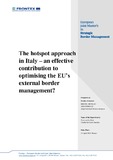The hotspot approach in Italy – an effective contribution to optimising the EU’s external border management?
Kokkuvõte
The goal of this research was to evaluate the impact of the hotspot approach for the effective management of the EU’s external borders, in particular in Italy. In order to complete the research successfully, a qualitative method based on mixed method techniques, consisting of in-depth interviews with key actors and a desk research on quantitative and qualitative sources, was chosen.From the results of the findings, we can conclude that the hotspot approach in Italy has been an effective contribution to the EU’s external border management by supporting the Italian authorities to fulfil their obligations under the EU legislation and enhancing the EU internal security.
Kirjeldus
1. The context ; 1.1. Introduction ; 1.2. The problem ; 1.3. Research questions and relevance ; 1.4. The dissertation ; 2. Literature review ; 2.1. Introduction ; 2.2. Globalisation, new threats and risks - conceptualizing ‘crisis’ ; 2.3. The EU as a crisis manager ; 2.4. The migratory crisis - EU Policy response ; 2.5. Hotspot approach – definition of the concept ; 2.6. One-stop-shop as the organisational model for implementation of the hotspot approach ; 2.7. The implementation phase in Italy – planned locations and sequential procedures ; 2.8. Fundamental rights concerns during the implementation phase ; 2.9. Chapter findings ; 3. Methodology ; 3.1. Introduction ; 3.2. Design ; 3.3. Data collection ; 3.3.1. Interviews ; 3.3.1.1. Sampling of the interviewees ; 3.3.1.2. The interview ; 3.3.1.3. The interview process ; 3.3.1.4. Analysis of the interviews ; 3.3.2. Desk research ; 3.3.2.1. Desk research analysis ; 3.4. Research quality indicators ; 3.5. Ethics ; 4. Analysis ; 4.1. Introduction ; 4.2. Interview Analysis ; 4.2.1. Theme A – Concept ; 4.2.2. Theme B – Response ; 4.2.3. Theme C – Decision-making and coordination ; 4.2.4. Theme D – Performance ; 4.2.5. Theme E – Outcome ; 4.2.6. Section key points ; 4.3. Desk research analysis ; 4.3.1. Data analysis ; 4.3.1.1. Number of migrants disembarked in Italy – hotspot or non-hotspot location ; 4.3.1.2. Objective 1 - Systematic identification and registration of all arriving migrants ; 4.3.1.3. Objective 2 - Swift channelling to the follow-up procedure of asylum, relocation or return ; 4.3.1.4. Indirect objective – Contribution to the EU internal security ; 4.3.1.5. Section key points ; 4.3.2. Hotspot approach evolution ; 4.3.2.1. EU Border management principles ; 4.3.2.2. From hotspot approach to controlled centres ; 4.3.2.3. The implementation in Italy ; 4.3.2.4. Section key points ; 5. Conclusions and recommendations ; 5.1. Introduction ; 5.2. Conclusion ; 5.3. Discussion and limitations ; 5.4. Recommendations



